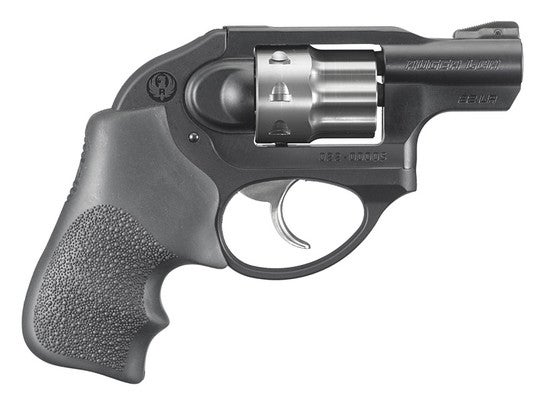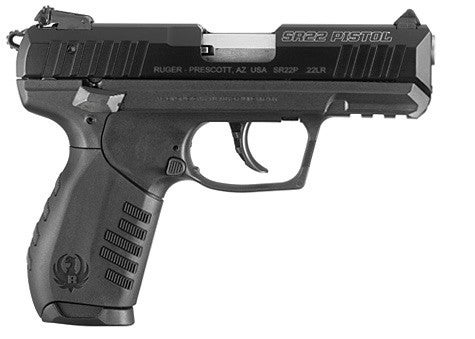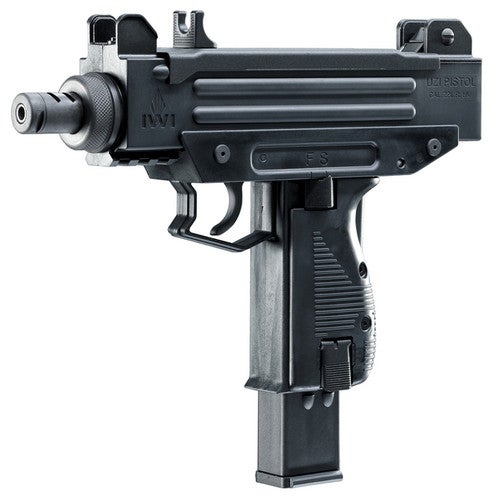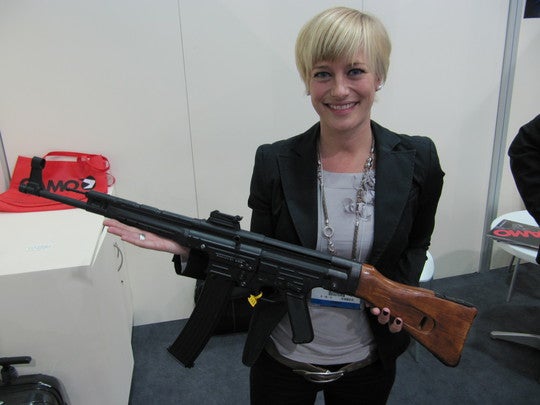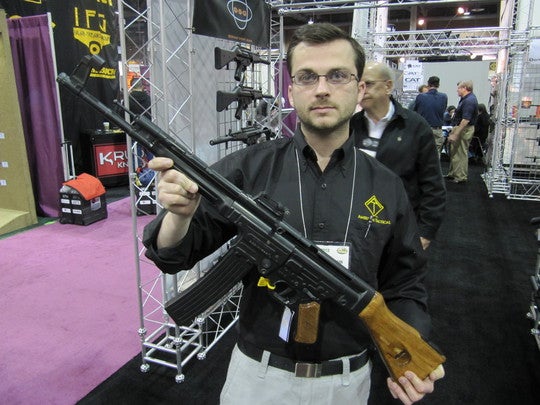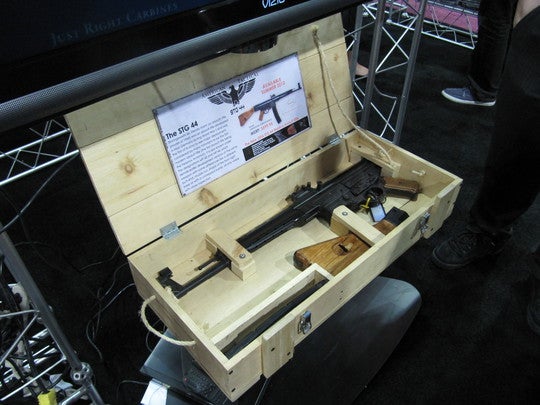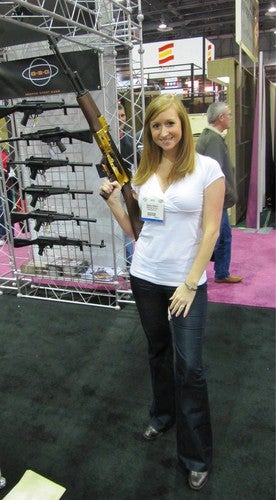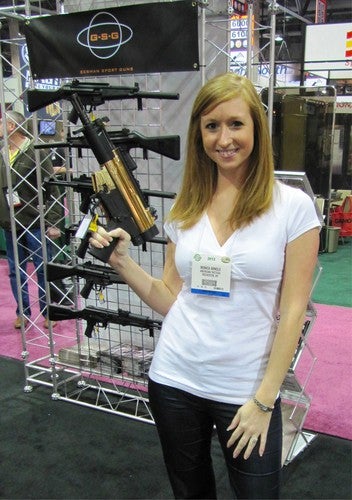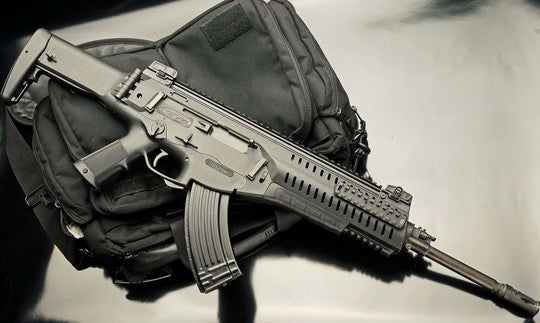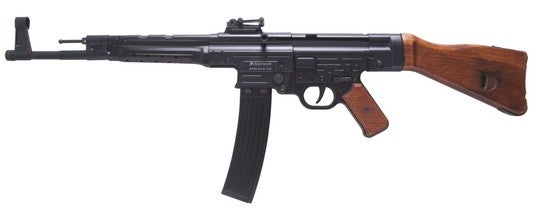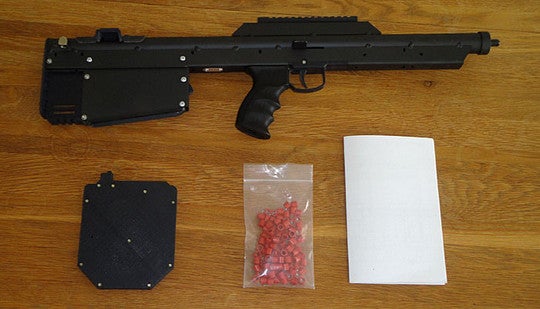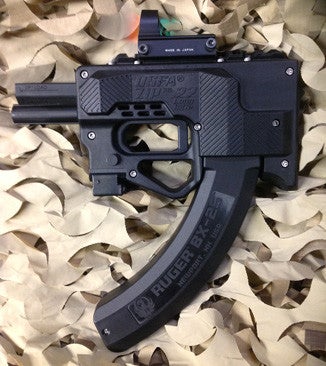
[ This guest post was written by Chris Baker of Bull City Defense. ]
Devoted followers of the 1911 design will tell you that a pistol in any caliber other than .45 can’t be a “real” 1911. Well, maybe they’re right, but ammo prices being what they are, there is no shame in embracing a 1911 chambered for a round that won’t break the bank. I personally have a fondness for the 9mm variety 1911s (which, despite what some of the so-called “purists” may imply, have been around since the 1950’s), but for cheap plinking on a 1911 platform, you can’t be a .22.
For owners of centerfire 1911s who want to maximize their trigger time for training purposes, a conversion kit is probably the ideal route. With a .22 conversion, the grip and trigger pull are not altered by swapping out the slide and barrel. But they tend to be pricey (for only half a gun, anyway), and hit or miss in terms of reliability. It’s also not always convenient to swap out a barrel and slide in the middle of a practice session on the range. For the practically-minded, budget-conscious shooter, one of the .22 caliber 1911 clones is probably a better bet. There are a few options in this category, but the one that caught my attention when it was released in the US last year is the GSG-1911. You may remember GSG, or German Sport Guns, for their MP5 and AK-47 patterend rifles, also chambered in .22. The initial press for the GSG-1911 really set it apart from similar pistols, boasting 80% parts compatibility with standard centerfire 1911s at an attractive price point.
I don’t know much about GSG’s history abroad, but they don’t have a ton of name recognition with the American market, so for many, the GSG-1911 is a bit of a toss-up. It’s priced right around $300-375, depending on the model and retailer. The one I purchased came with the cheap black rubber grips, but for a few bucks extra it can be had with more handsome wood grips. There’s also a model with a tactical rail and a fake suppressor. All versions seem to be widely available at a number of retailers online, and several of my local shops have had them in stock consistently since they were released. Extra magazines are about $35 each, which is close to what you’d pay for most centerfire pistol magazines, and you’ll want to pick up a couple since the pistol only comes with one. At first glance, the GSG-1911 looks well-made, has a decent looking finish, and has close to the same “heft” as a real 1911 style pistol, though it’s a few ounces lighter. But does it deserve to be in the same class as the more established rimfire legends that can be had in the same price range like the Ruger MKIII or the Browning Buckmark? Or is it even passable as a training substitute for a .45 1911? A few months back, I took the plunge and put down my $325 to find out.
First Impressions
After handling the GSG a bit, one of the first things I noticed was the tension in the grip safety. It sticks out quite a bit, and takes more force to activate than most other 1911 pistols I’ve handled. Besides being slightly uncomfortable, this won’t be a big deal for most people, unless you happen to have small hands. But more on that later. The other thing I noticed was that the thumb safety isn’t even slightly radiused, so that there’s a very sharp corner on it that digs into your thumb if you place it on top of the safety while firing. It’s an ambidextrous safety, but the right side lever has a much lower profile, so lefties may not have the same trouble that I did. Besides these two small gripes, I was, and remain very pleased with the overall build quality of the GSG-1911. Even the magazines seem very sturdy and I have no qualms about letting them drop free to the ground when performing reloads.
The trigger is nothing to write home about, but is still very usable. The overall weight of the trigger pull seemed to lessen a bit after shooting several hundred rounds, but there is still a “squishy” quality in it that might bother some people. However, I would imagine this will vary from one gun to the next. The sights on the GSG are a three dot style with yellow plastic “bumps” for the dots. They look pretty cheap, but might be a step up from the “convex hole with white paint” style sights that many pistols come with from the factory. The GSG ships with three front sights of different heights, so you can swap them out to get the point of aim that works best for your gun. The front sight sits in a loose dovetail, secured with a small hex screw, so to swap sights, you just remove the screw and slide the sight out. I tried all three different sights, and the only one that kept the shots even remotely on target at ranges from 5-25 yards was the medium height one. Again, your mileage may vary.
Ergonomics
Since buying the GSG, I’ve used it to introduce a few new shooters to the basics of handgun shooting. One aspect that some have appreciated, especially the women, is how easy it is to rack the slide. Racking the slide seems like such a simple thing to most experienced shooters, but to small-statured people who are unfamiliar with firearms, it can be both difficult and intimidating. The GSG’s slide is so easy to rack on my particular pistol that I can show people the proper technique and they don’t feel like there’s a huge risk of a heavy slide under great spring tension ready to snap their fingers off. The problem is that the people who appreciate the easy-to-rack slide the most are the same people who have trouble with the grip safety. For those with small hands, the grip safety can often barely be activated with the strong-hand thumb on top of the thumb safety. The grip they have to assume in order to activate the safety is awkward, to say the least, and for most of these shooters, I’ve just gone back to the Buckmark (which has a far less friendly slide). Part of the problem is most likely the curved mainspring housing. I have recently replaced it with a flat mainspring housing and hope to see a difference in the ease of use for shooters with smaller than average hands.
Surprise Safety “Feature”
Swapping out the mainspring housing also took care of another minor gripe I had with the pistol. Unlike any other 1911 patter pistol I’ve encountered, I was surprised to find that the GSG-1911 comes equipped with a magazine-disconnect safety. A small mechanism in the side of the factory mainspring housing prevents the trigger from engaging when there is no magazine inserted. This may have been done to make the pistol compliant with certain states’ laws, but aside from that, I find it completely unnecessary. Fortunately, one does not have to completely replace the mainspring housing in order to deactivate the safety. By simply removing the extraneous parts from the cavity in the side of the factory MSH, the safety will no longer pose a problem. Normally, I would not publically advocate disabling a factory safety mechanism in a firearm, but since millions of 1911 pistols are handled safely every day without such a safety, I feel confident in promoting the removal of the magazine safety on the GSG-1911.
Reliability
After firing a couple of thousand rounds of varying brands, I would rate the GSG-1911’s reliability as perfectly adequate. With the spotty reliability of .22 ammo, it’s sometimes hard to know whether the ammo or the gun is causing the problem, but with quality ammo, the GSG functions quite well. I fired a box of Remington “Golden Bullet Value Pack”, a box of Federal “AutoMatch Bulk Pack”, some standard velocity CCI, a few boxes of CCI “Mini-Mags”, and a few boxes of Remington “Thunderbolt”. I had the most reliability problems using the Remington “Golden Bullet”, and the Federal “AutoMatch”, with several ignition failures and a few failures to eject (stovepipes) with both brands. Reliability was not flawless with the other brands, but seemed very consistent as long as the gun was well lubricated before use. I noticed very early on that in order to ensure proper feeding, it’s very important to make sure all the rounds are seated as far back in the magazine as they can go. The top round, especially, must be pointed up at an angle and not nose diving down into the mag before it is loaded. I’ve found the best way to do this is to use the thumb stud on the magazine spring to relieve tension on the mag after loading, and tilt the whole magazine backwards so the rounds fall all the way to the rear of the magazine. This only takes a second after loading each mag and results in much better performance.
Accuracy
While I wouldn’t consider the GSG-1911 to be a dedicated “target” pistol, it’s certainly accurate enough to fill the role of a training pistol for centerfire 1911s. I did a quick bench rest test at 15 yards using CCI mini-mags and got decent results, with most five shot groups coming in around 1.5 inches. Not particularly impressive when held against many other .22 pistols in the same price range, but certainly “combat accurate”.
For me, what holds the gun back in the practical accuracy department is the sights. At first, I thought the rear notch seemed abnormally narrow, making it difficult to quickly acquire a sight picture. However, when I measured the width of the notch compared to another 1911, they were the same, as well as the width of the front sight. It was when doing that comparison that I realized the shape of the rear sight on the GSG slopes inward on the sides, which seems to trick my eyes into seeing the notch as narrow. Without understanding the exact physiology behind it, I have to assume that there is a reason most rear sights are not shaped this way. All that said, both the front and rear sights are secured into standard dovetail cuts in the slide, so users can swap the sights out for whatever replacements they wish.
Additional Features
Fortunately, many of the complaints I’ve had with this pistol are easily fixed by replacing small parts with other standard 1911 parts. I don’t know if GSG’s claim of 80% parts compatibility is accurate, but as far as I can tell, most of the parts I would like to see changed are standard. It’s annoying to buy a pistol with features on it that I don’t like, but it really does make economic sense both for GSG and for the consumer. By using cheaper parts, GSG is able to keep the price for this pistol extremely competitive. Many users will not notice or care about the cheap parts, and those that do can easily swap them for their favorite standard 1911 parts. It may take a little doing, but the majority of customers should be able to simply spend a few bucks on parts (maybe some fitting here and there) to get the GSG set up similar to their favorite centerfire 1911. Some missing features, of course, will require the intervention of a skilled gunsmith, such as the lack of any texturing on the front strap, or the absence of forward cocking serrations.
Also similar to the traditional 1911 is the GSG’s field stripping procedure, with the exception of a little twist. After removing the slide stop, you must also remove an additional pin that’s underneath the slide stop, and a small hex screw that’s just forward of the slide stop. After that, the slide comes right off, and the rest of the disassembly is fairly straightforward. It’s a tad annoying to have to use a tool for breakdown, but really only an issue if you happen to need to tear down the pistol somewhere away from your normal workbench.
As I mentioned earlier, one version of the GSG comes equipped with a fake suppressor. GSG may have been at least partially motivated to create this version just so they could highlight a unique feature of the GSG; the inclusion of a factory threaded barrel. All versions of the GSG come with a threaded barrel, and include a small wrench to remove the thread protector. The threads accept the same adapter as the Walther P22, so silencer fans have one less step to set up a super-cool, super-quiet 1911. If you don’t care to attach a suppressor, then no problem. The thread protector is secured very firmly to the barrel and you can completely ignore it if you wish.
Usability Comparison
If the GSG-1911 is to be used as a practice stand-in for a centerfire 1911, then they have to function and feel similar the range. Of course, as Todd Green points out in this excellent article, a .22 is only a good training substitute for a defensive handgun in certain disciplines. Any skills that require fast follow-up shots or recoil management can only be improved by using the “real thing”. However, skills like drawing from the holster, speed reloading, and to some extent, shooting on the move, can benefit greatly from training with a .22. With that in mind, I have been using my GSG-1911 to warm up at the range before transitioning to my current centerfire 1911 of choice; a 9mm STI Trojan.
While there are some definite ergonomic differences between the two pistols, I don’t notice them a great deal while shooting unless I am going for a more lengthy practice session. The most notable difference between the two pistols when shooting is the sights, but as I mentioned earlier, that can be easily remedied. I believe I’ve gotten the biggest benefit out of using the GSG to practice my draw stroke. Since the GSG has a standard 1911 profile, it fits perfectly into my Blackhawk CQC holster. My 1911 mag holders work fine for the GSG magazines as well. When switching from the GSG to the STI for draw practice, I do notice that the STI feels much heavier out of the holster. Those ounces of difference in the weight feel a lot more like pounds when trying to get the pistol on target quickly. However, I timed myself several times drawing from the holster and putting a single shot on target at 7 yards and the average was only .03 seconds slower with the STI. So while the all-steel STI “feels” heavier and slower out of the holster, it doesn’t seem to make much difference practically, and adding extra rounds to my draw practice with the GSG over the last few months has definitely improved my overall average times.
Overall Value
When compared to other .22 handguns in the $300-400 range, it’s hard to say that the GSG-1911 comes out on top in any specific category. If a new shooter were to ask for a recommendation at that price point, I would almost certainly point them toward something like a Ruger 22/45, which comes in several varieties, some of them significantly less expensive than the GSG. However, though there are more accurate, more durable .22s out there, there are few available in that price range that have the same feel and controls as serious defensive handguns. This makes the GSG better not just for training, but in my opinion, also makes it a really fun gun to shoot. The fact that I can use the same holster, the same mag holders, and run the gun in the same drills I use for my “real” 1911 makes it a blast to have out on the range. When I look at the rapidly degrading finish and the cheap sights on my GSG, it’s hard to love it. But then I look at the ammo boxes on the table and wonder how they got empty so quicky, and I realize that I’ve gotten more than my money’s worth.























